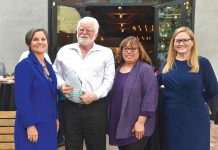At first glance, the Pinnacles National Monument 25 miles south
of Hollister might not seem to have much connection with our
nation’s new Hawaiian marine sanctuary. The often arid Pinnacles is
a completely different terrain to the tropical fish paradise in the
Pacific Ocean. But last month, the connection was made.
At first glance, the Pinnacles National Monument 25 miles south of Hollister might not seem to have much connection with our nation’s new Hawaiian marine sanctuary. The often arid Pinnacles is a completely different terrain to the tropical fish paradise in the Pacific Ocean. But last month, the connection was made.
On June 15, President Bush made a public proclamation creating the Northwestern Hawaiian Islands Marine National Monument. It’s fitting that he did it in the same month – 100 years almost to the day after – the Antiquities Act of 1906 became law.
If you’ve never heard of this important piece of legislation, it’s the law that lets U.S. presidents establish protection over many of America’s natural and cultural treasures – including the Statue of Liberty in New York Harbor, the Pinnacles and our nation’s new Hawaiian national monument.
The act is considered a major milestone in the conservation movement in America. Its primary architect was John F. Lacey, a Republican from Iowa who served 16 years in the House of Representatives. During the Civil War, while in the Union Army, this extraordinary man taught himself the legal trade by studying law books between battles. In Congress, he focused his legal skills in efforts to preserve our nation’s magnificent wilderness.
Lacey has gone down in U.S. history as “The Father of Federal Conservation Legislation.” He chaired the House Public Lands Committee for 12 years, authoring many of America’s first bills creating and protecting our national parks.
He also worked closely with Gifford Pinchot, the father of American forestry, to initiate a workable federal forestry management program. His Bird Act of 1900 was a significant achievement in the protection of American wildlife. And his various bills helped in the preservation of American archeological sites such as prehistoric Native American ruins.
Lacey’s Antiquities Act, however, is his crowning political achievement. Passed almost unanimously, it was gleefully signed by President Theodore Roosevelt on June 8, 1906. Three months later, Roosevelt used it to make Wyoming’s Devils Tower our country’s first national monument. In 1908, he used it to create the Pinnacles National Monument.
And this month, Bush used it to make the Northwestern Hawaiian Islands our 75th national monument. At 140,000 square miles – about the size of California – it’s larger than all of America’s national parks combined.
Most people in South Valley appreciate the natural world that makes our Central Coast region a great place to live. We care about the environment because it’s an integral part of our community. Our local economy and the quality of our lives are directly tied to nature.
I believe most of us want to emulate the conservation philosophy Lacey and Roosevelt established with their historic law. America must protect its heritage – both natural and cultural – as a precious resource for its citizens. One of the greatest strengths we have as a nation is our wilderness and our surrounding oceans.
Unfortunately in recent years, that strength has come under threat by politicians in Washington who have developed pay-for-play relationships with oil, logging and mining interests. Some of our elected representatives – people in positions of great political power – believe the natural environment is wide open to commercial exploitation for short-term monetary and political gain.
These representatives have been corrupted by a system in which lobbyist dollars come before democracy. Unfortunately, one of these elected officials represents the South Valley.
District 11’s Congressman Richard Pombo has become a traitor to his own Republican party’s legacy of conservation. Last September, a few days after trying to raze the historic Endangered Species Act of 1973, Pombo introduced a bill into the House that would have auctioned off 15 of America’s national parks and monuments as well as open the Arctic National Wildlife Refuge to “energy or commercial development.”
And on June 29 – 14 days after President Bush created the Hawaiian Islands Marine National Monument, the House passed Pombo’s bill devised to end the historic moratorium of drilling for oil off our nation’s shores. In the last 25 years that this moratorium has existed, it has received an overwhelming thumbs-up approval from the American people – and bipartisan support from elected leaders.
Gov. Arnold Schwarzenegger, a fellow Republican, saw that the congressman’s oil-drilling proposal is bad news. California’s governor sent him a sternly worded letter warning of the “adverse” environmental and economic impact from drilling off California’s coast. Schwarzenegger’s letter told Pombo that a better way to make America energy independent is to focus on energy-efficiency programs and the development of renewable fuels.
According to the Sierra Club, if we opened America’s coastal waters to oil and natural gas drilling today, the petroleum would not reach our pumps until 2013. Our nation would be better off focusing those seven years on developing cleaner, more efficient, and renewable energy alternatives to crude.
Last year, Richard Pombo ranked fourth in the House of Representatives in campaign funding received from oil companies. From his actions with his recent offshore oil-drilling bill, it’s not hard to see with whom his allegiance is truly tied.
America’s shorelines, national parks, monuments and wildlife refuges belong to all its citizens. We must not sell off our inheritance for the short-term financial profit of a few corporations. We must protect it to preserve a basic human need – a respectful connection to nature.
Congressman John F. Lacey knew that. A man of great vision, he saw wilderness beyond mere pocketbook value. He realized we’ve been given a sacred duty to care for the gifts of nature God gave our nation. Lacey’s 1906 law set the example for us to pass our natural inheritance along to future generations.
Perhaps Lacey’s friend Teddy Roosevelt put it best when he admonished his audience at the 1908 dedication of Grand Canyon National Monument:
“Keep it for you children and your children’s children and all who come after you.”
One hundred years after the establishment of the historic Antiquities Act, I hope we as a people might heed Roosevelt’s words of wisdom.










